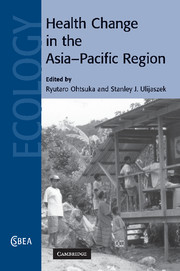Book contents
- Frontmatter
- Contents
- List of contributors
- Acknowledgements
- 1 Health change in the Asia-Pacific region: disparate end-points?
- 2 Interactions of nutrition, genetics and infectious disease in the Pacific: implications for prehistoric migrations
- 3 Biocultural adaptation and population connectedness in the Asia-Pacific region
- 4 Changing nutritional health in South East Asia
- 5 Obesity and nutritional health in Hong Kong Chinese people
- 6 Modernization, nutritional adaptability and health in Papua New Guinea Highlanders and Solomon Islanders
- 7 Tongan obesity: causes and consequences
- 8 Nutrition and health in modernizing Samoans: temporal trends and adaptive perspectives
- 9 Health patterns of Pacific Islanders and Asians in the United States
- 10 Impacts of modernization and transnationalism on nutritional health of Cook Islanders
- 11 Mortality decline in the Pacific: economic development and other explanations
- 12 Health changes in Papua New Guinea: from adaptation to double jeopardy?
- Index
- References
9 - Health patterns of Pacific Islanders and Asians in the United States
Published online by Cambridge University Press: 15 September 2009
- Frontmatter
- Contents
- List of contributors
- Acknowledgements
- 1 Health change in the Asia-Pacific region: disparate end-points?
- 2 Interactions of nutrition, genetics and infectious disease in the Pacific: implications for prehistoric migrations
- 3 Biocultural adaptation and population connectedness in the Asia-Pacific region
- 4 Changing nutritional health in South East Asia
- 5 Obesity and nutritional health in Hong Kong Chinese people
- 6 Modernization, nutritional adaptability and health in Papua New Guinea Highlanders and Solomon Islanders
- 7 Tongan obesity: causes and consequences
- 8 Nutrition and health in modernizing Samoans: temporal trends and adaptive perspectives
- 9 Health patterns of Pacific Islanders and Asians in the United States
- 10 Impacts of modernization and transnationalism on nutritional health of Cook Islanders
- 11 Mortality decline in the Pacific: economic development and other explanations
- 12 Health changes in Papua New Guinea: from adaptation to double jeopardy?
- Index
- References
Summary
Introduction
Any analysis of the health of the Asian and Pacific Islander (API) populations in the United States immediately confronts the obstacle that, as late as the year 2000, ‘Asian and Native Hawaiian/Pacific Islanders have to a large degree been “invisible” in public health debates’, and that there are large gaps in our understanding of the ‘factors that influence their health and quality of life’ (Srinivasan and Guillermo 2000: 1731). A major reason for such gaps is that the comparatively small size of many API subpopulations results in data sets with an insufficient number of cases to allow stable and reliable statistical estimates. Assessing API health in the United States requires drawing on a number of different data sources across which information is not always fully consistent. With the partial exception of Hawaiians, information on specific Pacific Islander populations is especially scarce, so that it is often necessary to assess the health of this group as if it were an undifferentiated whole. In fact, much more often than is desirable, Pacific Islanders are subsumed within a combined Asian and Pacific Islander category. Nevertheless, by employing information from a number of different sources, including our own analyses, we believe a useful assessment of the physical health of the API population in the United States can be achieved.
Demographic and socioeconomic characteristics
The API population is quite heterogeneous in demographic, socioeconomic status (SES) and cultural terms, as well as in length of settlement (Srinivasan and Guillermo 2000; Barnes and Bennett 2002; Ro 2002; Reeves and Bennett 2003).
- Type
- Chapter
- Information
- Health Change in the Asia-Pacific Region , pp. 192 - 218Publisher: Cambridge University PressPrint publication year: 2007

